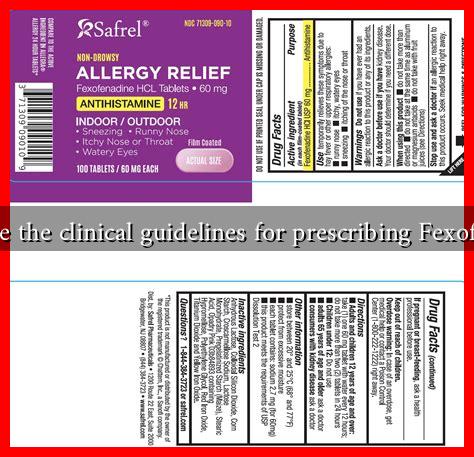-
Table of Contents
What are the Clinical Guidelines for Prescribing Fexofenadine?
Fexofenadine is a second-generation antihistamine commonly used to treat allergic rhinitis and chronic urticaria (hives). As a non-sedating agent, it offers relief from allergy symptoms without the drowsiness associated with first-generation antihistamines. This article explores the clinical guidelines for prescribing fexofenadine, including indications, dosage, contraindications, and patient considerations.
Indications for Fexofenadine
Fexofenadine is primarily indicated for the treatment of:
- Seasonal allergic rhinitis (hay fever)
- Perennial allergic rhinitis
- Chronic idiopathic urticaria
According to the American Academy of Allergy, Asthma & Immunology (AAAAI), fexofenadine is effective in alleviating symptoms such as sneezing, runny nose, itchy or watery eyes, and hives. Its rapid onset of action and long duration of effect make it a preferred choice for many patients.
Dosage Guidelines
The recommended dosage of fexofenadine varies based on the patient’s age and specific condition:
- Adults and children over 12 years: 60 mg twice daily or 180 mg once daily.
- Children aged 6 to 11 years: 30 mg twice daily.
- Children under 6 years: Consult a physician for appropriate dosing.
It is essential to note that fexofenadine should be taken with water and not with fruit juices (like orange or grapefruit juice), as these can reduce its absorption.
Contraindications and Precautions
While fexofenadine is generally well-tolerated, certain contraindications and precautions should be considered:
- Hypersensitivity: Patients with a known allergy to fexofenadine or any of its components should avoid its use.
- Renal impairment: Caution is advised in patients with renal dysfunction, as dosage adjustments may be necessary.
- Pregnancy and lactation: Although fexofenadine is classified as a Category C drug, it should only be used if the benefits outweigh the risks.
Healthcare providers should conduct a thorough medical history and medication review to identify any potential interactions or contraindications.
Patient Considerations
When prescribing fexofenadine, healthcare providers should consider the following:
- Patient Education: Inform patients about the importance of adhering to the prescribed dosage and timing.
- Monitoring: Regular follow-ups may be necessary to assess the effectiveness of the treatment and make any necessary adjustments.
- Side Effects: While fexofenadine is less likely to cause sedation, patients should be informed about possible side effects, including headache, dizziness, and gastrointestinal disturbances.
In a study published in the Journal of Allergy and Clinical Immunology, it was found that patients who adhered to their fexofenadine regimen reported a significant reduction in allergy symptoms compared to those who did not follow the prescribed guidelines.
Conclusion
Fexofenadine is a valuable option for managing allergic conditions due to its efficacy and favorable side effect profile. By adhering to clinical guidelines regarding indications, dosages, contraindications, and patient considerations, healthcare providers can optimize treatment outcomes for their patients. As with any medication, ongoing patient education and monitoring are crucial to ensure safety and effectiveness. For more detailed information on fexofenadine and its clinical applications, healthcare professionals can refer to resources such as the American Academy of Allergy, Asthma & Immunology.




